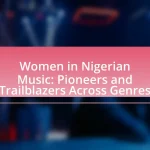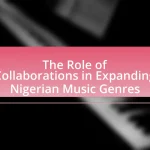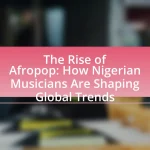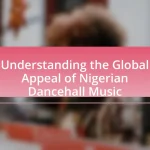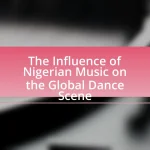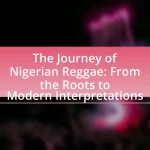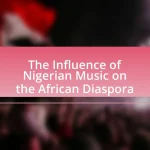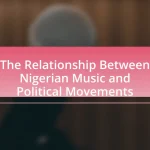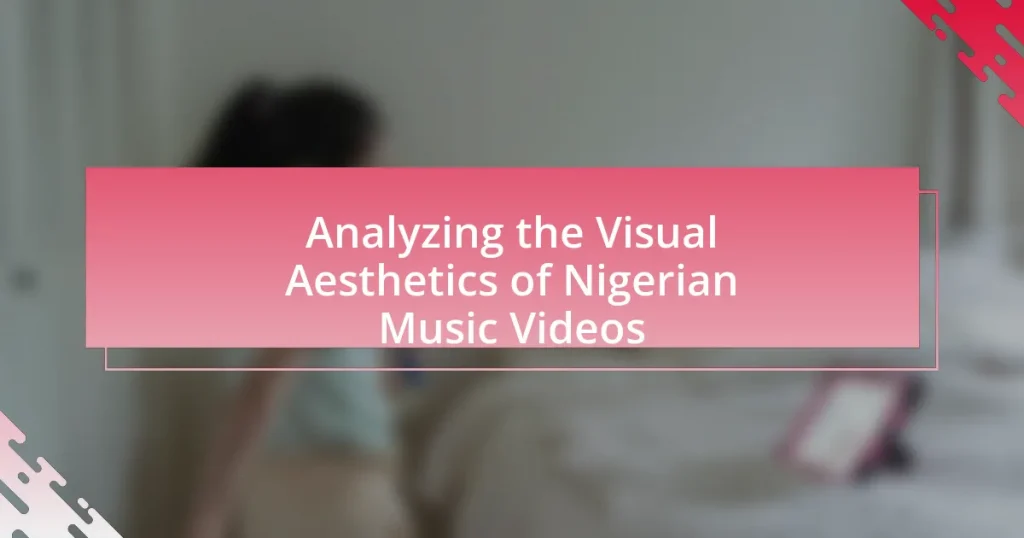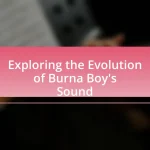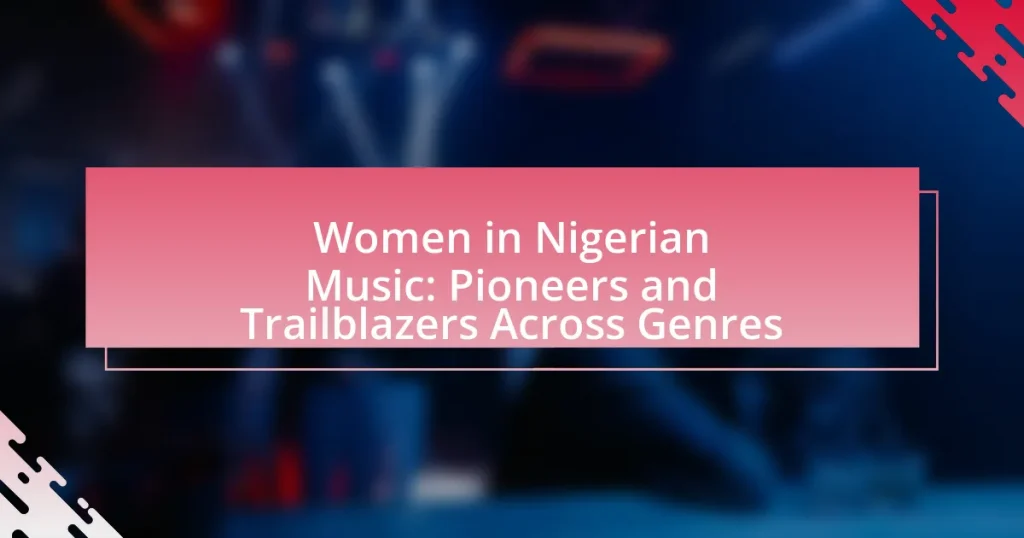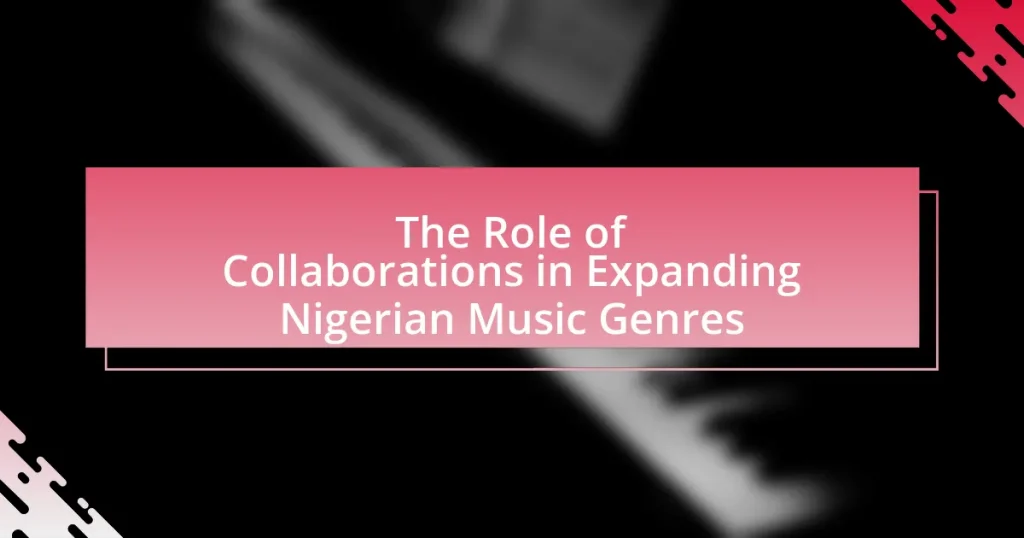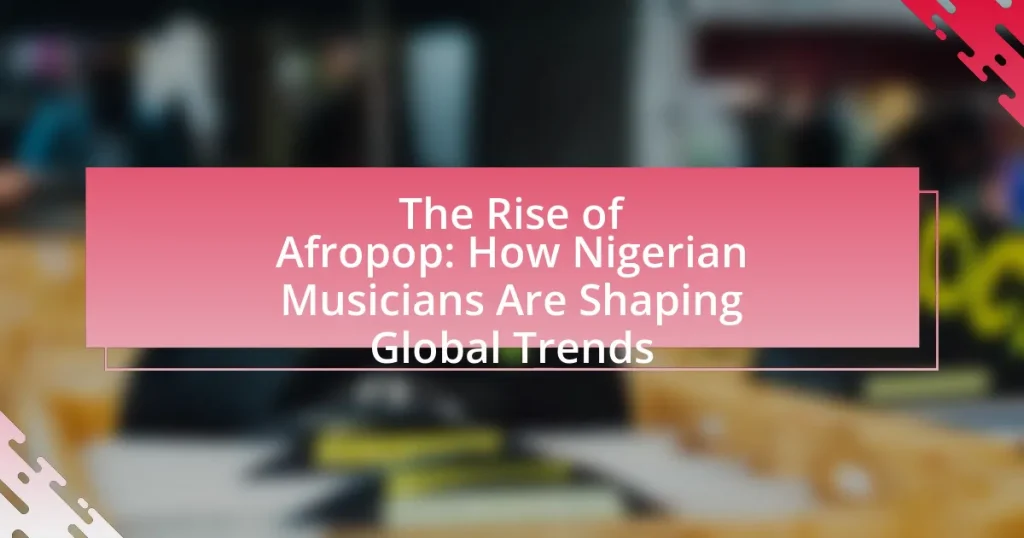The article analyzes the visual aesthetics of Nigerian music videos, highlighting their vibrant colors, dynamic choreography, and culturally rich imagery that reflect Nigeria’s diverse heritage and contemporary urban life. It discusses how these visual elements influence audience perception and emotional engagement, emphasizing the importance of high production values and innovative cinematography. Key components such as costume and set design, along with the impact of cultural factors, are examined to illustrate how they shape the narrative and enhance storytelling. Additionally, the article compares Nigerian music videos to global trends, identifying similarities and differences in themes and styles, while also exploring the role of technological advancements in elevating visual quality.
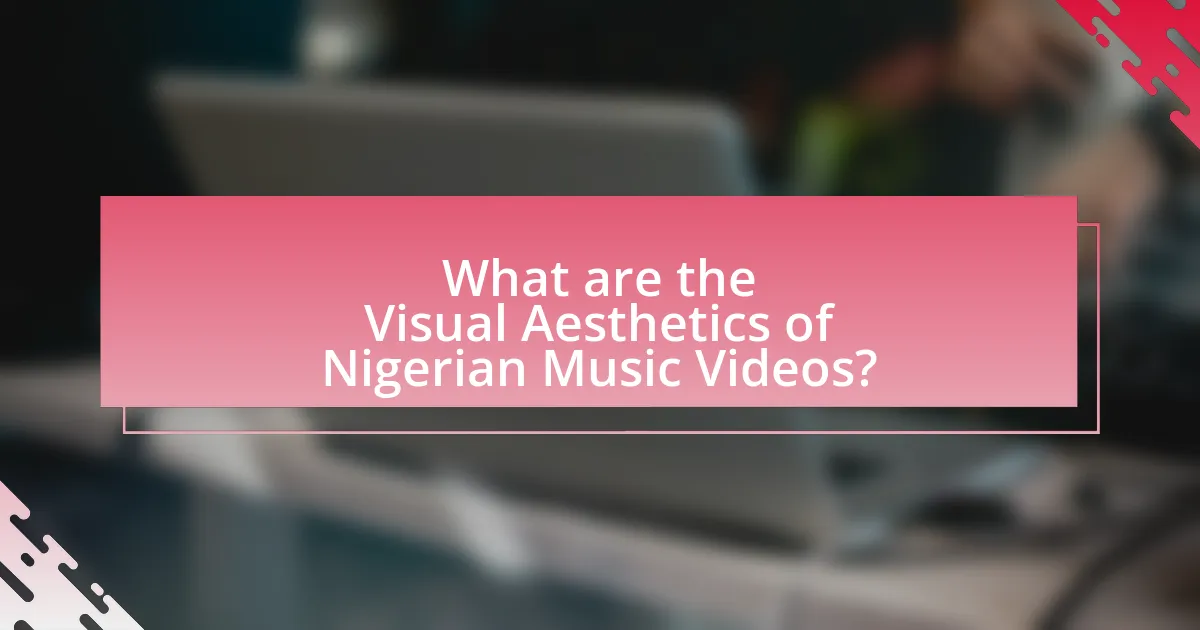
What are the Visual Aesthetics of Nigerian Music Videos?
The visual aesthetics of Nigerian music videos are characterized by vibrant colors, dynamic choreography, and culturally rich imagery. These elements reflect Nigeria’s diverse cultural heritage and contemporary urban life, often incorporating traditional attire, local landscapes, and modern settings. The use of high production values, including advanced cinematography and editing techniques, enhances the overall visual appeal. Additionally, themes of celebration, identity, and social commentary are frequently depicted, making the visuals not only entertaining but also reflective of societal issues. This aesthetic approach has contributed to the global popularity of Nigerian music, particularly in genres like Afrobeats, where visuals play a crucial role in storytelling and audience engagement.
How do visual aesthetics influence the perception of Nigerian music videos?
Visual aesthetics significantly influence the perception of Nigerian music videos by shaping audience engagement and emotional response. High-quality visuals, including vibrant colors, dynamic camera angles, and elaborate set designs, enhance the storytelling aspect of the music, making it more appealing and relatable to viewers. Research indicates that visually striking elements can increase viewer retention and enjoyment, as seen in the popularity of Nigerian artists like Burna Boy and Wizkid, whose videos often feature rich cultural imagery and contemporary fashion. This combination of aesthetics not only attracts a broader audience but also reinforces cultural identity, thereby elevating the overall impact of the music within both local and global contexts.
What elements contribute to the visual aesthetics in these videos?
The elements that contribute to the visual aesthetics in Nigerian music videos include vibrant color palettes, dynamic camera angles, and culturally relevant imagery. Vibrant color palettes enhance emotional engagement and reflect the lively nature of Nigerian culture. Dynamic camera angles create visual interest and maintain viewer attention, often incorporating fast cuts and movement to match the rhythm of the music. Culturally relevant imagery, such as traditional attire and local landscapes, grounds the videos in Nigerian identity, making them relatable to the audience. These elements collectively enhance the overall visual appeal and cultural resonance of the videos.
How do cultural factors shape the visual presentation of Nigerian music videos?
Cultural factors significantly shape the visual presentation of Nigerian music videos by influencing themes, aesthetics, and storytelling techniques. The rich diversity of Nigeria’s ethnic groups, languages, and traditions is reflected in the vibrant costumes, dance styles, and settings used in these videos, which often incorporate elements from local customs and folklore. For instance, the use of traditional attire and local dialects in music videos not only showcases cultural heritage but also resonates with audiences, enhancing relatability and emotional connection. Additionally, the incorporation of social issues, such as politics and community life, in the narratives of these videos further emphasizes the cultural context, making them a powerful medium for expression and commentary. This alignment with cultural identity is supported by the popularity of genres like Afrobeats, which blend contemporary sounds with traditional influences, illustrating how cultural factors are integral to the visual and thematic composition of Nigerian music videos.
Why are visual aesthetics important in the context of Nigerian music videos?
Visual aesthetics are crucial in Nigerian music videos because they enhance storytelling and cultural representation. The vibrant colors, intricate costumes, and dynamic cinematography reflect Nigeria’s rich cultural heritage and resonate with audiences both locally and globally. For instance, the use of traditional motifs and contemporary styles in videos by artists like Burna Boy and Tiwa Savage not only captivates viewers but also promotes Nigerian culture on international platforms. This visual appeal can significantly influence audience engagement and the commercial success of the music, as studies show that visually striking content increases viewer retention and sharing on social media.
What role do visuals play in storytelling within Nigerian music videos?
Visuals play a crucial role in storytelling within Nigerian music videos by enhancing narrative depth and emotional engagement. The imagery used in these videos often reflects cultural themes, social issues, and personal experiences, allowing viewers to connect with the music on a deeper level. For instance, vibrant colors, traditional attire, and urban landscapes are frequently employed to convey the artist’s message and cultural identity. Research indicates that visuals can significantly influence audience perception and interpretation, as seen in the works of artists like Burna Boy and Wizkid, whose videos often incorporate storytelling elements that resonate with both local and global audiences. This integration of visuals not only captivates viewers but also reinforces the song’s themes, making the overall experience more impactful.
How do visuals enhance the emotional impact of the music?
Visuals enhance the emotional impact of music by creating a multisensory experience that deepens audience engagement. When visuals are synchronized with music, they can evoke specific emotions, reinforce lyrical themes, and provide context that amplifies the overall message. For instance, studies have shown that music videos featuring vibrant colors and dynamic imagery can elicit stronger emotional responses compared to audio alone, as demonstrated in research by Hargreaves and North, which highlights the role of visual elements in shaping emotional perceptions of music. This synergy between sound and sight allows viewers to connect more profoundly with the music, making the emotional experience more vivid and memorable.
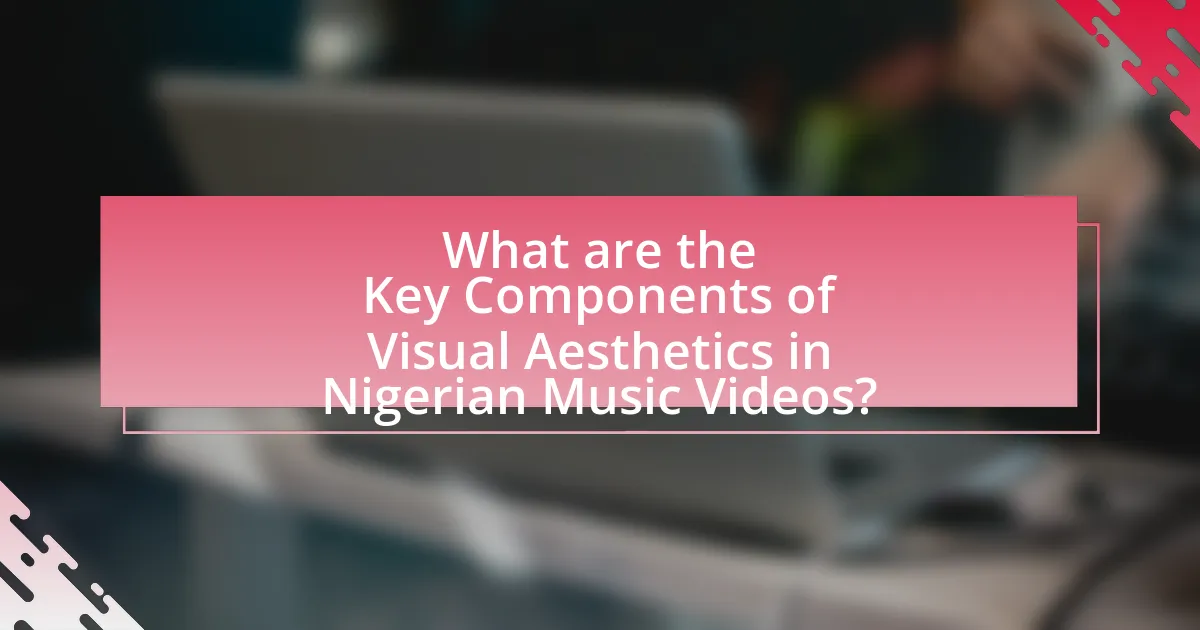
What are the Key Components of Visual Aesthetics in Nigerian Music Videos?
The key components of visual aesthetics in Nigerian music videos include vibrant color palettes, dynamic choreography, culturally relevant costumes, and innovative cinematography. Vibrant color palettes enhance emotional engagement and reflect the energetic nature of the music, while dynamic choreography showcases the rhythm and movement integral to the genre. Culturally relevant costumes often incorporate traditional attire, symbolizing heritage and identity, which resonates with the audience. Innovative cinematography techniques, such as aerial shots and creative transitions, contribute to a visually captivating experience, making the videos memorable and impactful. These elements collectively create a rich visual narrative that complements the music and engages viewers effectively.
How does cinematography affect the overall aesthetic of Nigerian music videos?
Cinematography significantly influences the overall aesthetic of Nigerian music videos by shaping visual storytelling through camera angles, lighting, and composition. The use of vibrant colors and dynamic camera movements enhances the cultural expressions and emotional depth of the narratives presented in these videos. For instance, the incorporation of traditional settings and contemporary urban landscapes creates a juxtaposition that reflects Nigeria’s rich cultural heritage and modern influences. Studies indicate that high-quality cinematography can increase viewer engagement and emotional resonance, making the visuals more appealing and memorable. This is evident in popular Nigerian music videos that utilize innovative techniques, such as aerial shots and slow-motion effects, to create a visually captivating experience that resonates with audiences both locally and internationally.
What techniques are commonly used in cinematography for these videos?
Common techniques used in cinematography for Nigerian music videos include vibrant color grading, dynamic camera movements, and creative framing. Vibrant color grading enhances the visual appeal and reflects cultural themes, while dynamic camera movements, such as tracking and panning, create an engaging viewing experience. Creative framing, including the use of close-ups and wide shots, helps convey emotions and narratives effectively. These techniques are essential in establishing the energetic and expressive nature of Nigerian music videos, which often aim to resonate with diverse audiences.
How does lighting contribute to the mood and tone of the visuals?
Lighting significantly influences the mood and tone of visuals by affecting color perception, shadow dynamics, and overall ambiance. In Nigerian music videos, for instance, bright lighting can evoke feelings of joy and celebration, while dim or colored lighting can create a sense of intimacy or drama. Research indicates that different lighting techniques, such as high-key lighting for a cheerful atmosphere or low-key lighting for suspense, directly impact viewer emotions and interpretations. This relationship between lighting and emotional response is supported by studies in film theory, which demonstrate that lighting choices are crucial in shaping narrative and aesthetic experiences.
What role does costume and set design play in visual aesthetics?
Costume and set design significantly enhance visual aesthetics by establishing the mood, character identity, and cultural context within Nigerian music videos. These elements work together to create a cohesive visual narrative that resonates with the audience. For instance, vibrant costumes and culturally relevant set designs can evoke specific emotions and reflect the themes of the music, thereby enriching the viewer’s experience. Research indicates that well-executed costume and set design can increase audience engagement and retention, as they visually communicate the story and cultural nuances inherent in the music.
How do costumes reflect cultural identity in Nigerian music videos?
Costumes in Nigerian music videos reflect cultural identity by showcasing traditional attire, contemporary fashion, and regional styles that signify ethnic heritage. These visual elements serve as a medium for artists to express their roots, connect with their audience, and celebrate Nigeria’s diverse cultures. For instance, the use of vibrant colors and patterns in costumes often represents specific ethnic groups, such as the Yoruba, Igbo, or Hausa, highlighting their unique cultural narratives. Additionally, the incorporation of modern fashion trends alongside traditional garments illustrates the fusion of cultural identities, emphasizing the dynamic nature of Nigerian society. This interplay between traditional and contemporary styles not only reinforces cultural pride but also promotes a sense of belonging among viewers, making costumes a vital aspect of cultural representation in Nigerian music videos.
What impact does set design have on the narrative of the music video?
Set design significantly influences the narrative of a music video by establishing the visual context and emotional tone. The choice of colors, props, and spatial arrangements can enhance storytelling by reflecting the themes and emotions conveyed in the lyrics. For instance, a vibrant, urban set can evoke feelings of energy and excitement, aligning with upbeat music, while a minimalist, dark setting may underscore themes of introspection or melancholy. Research indicates that viewers often interpret the narrative based on visual cues, with set design playing a crucial role in shaping their understanding and emotional response to the music video.
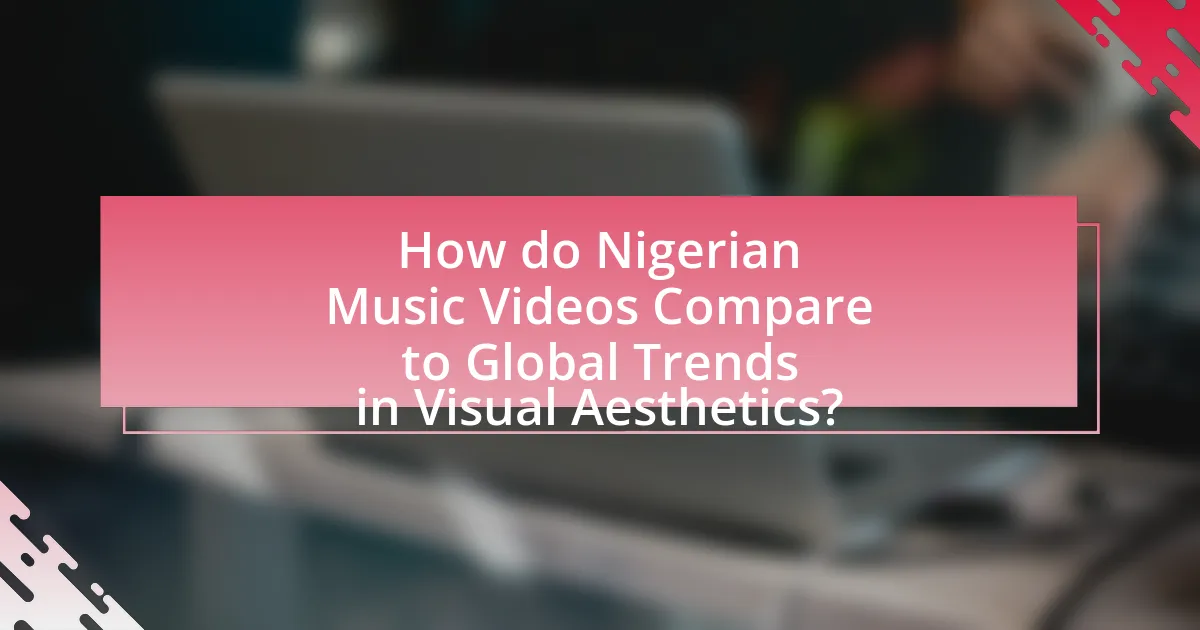
How do Nigerian Music Videos Compare to Global Trends in Visual Aesthetics?
Nigerian music videos often blend vibrant colors, cultural motifs, and storytelling elements, distinguishing them from global trends that may prioritize minimalism or high production values. While global music videos frequently emphasize sleek visuals and advanced technology, Nigerian productions showcase local fashion, dance, and social narratives, reflecting the country’s rich cultural heritage. For instance, the use of traditional attire and local settings in videos by artists like Burna Boy and Wizkid highlights a commitment to cultural representation, contrasting with the more universal themes often seen in Western music videos. This unique approach not only appeals to local audiences but also resonates globally, as evidenced by the increasing popularity of Afrobeats and its visual style on platforms like YouTube, where Nigerian music videos have garnered millions of views, showcasing their impact on the global music scene.
What similarities and differences exist between Nigerian and Western music videos?
Nigerian and Western music videos share similarities in their use of vibrant visuals and storytelling, but they differ significantly in cultural representation and thematic focus. Both types of music videos often feature high production values, engaging choreography, and a strong emphasis on fashion. However, Nigerian music videos frequently incorporate local cultural elements, such as traditional attire and indigenous dance styles, reflecting the country’s diverse heritage. In contrast, Western music videos may prioritize global trends and individualism, often showcasing a more commercialized aesthetic. Additionally, themes in Nigerian music videos often revolve around community, spirituality, and social issues, while Western music videos may focus more on personal relationships and lifestyle. This distinction highlights the cultural narratives that shape the visual aesthetics of each region’s music videos.
How do themes and styles differ across cultures in music videos?
Themes and styles in music videos differ significantly across cultures due to varying cultural values, traditions, and societal norms. For instance, Nigerian music videos often emphasize communal celebrations, vibrant colors, and traditional attire, reflecting the importance of community and cultural heritage in Nigerian society. In contrast, Western music videos may focus on individualism, luxury, and personal expression, often showcasing high fashion and urban settings. This divergence is supported by the fact that Nigerian music videos frequently incorporate local dance styles and folklore, while Western videos might prioritize narrative-driven plots or abstract visuals. Such differences highlight how cultural context shapes the artistic choices made in music video production.
What can Nigerian music videos learn from global visual trends?
Nigerian music videos can learn to enhance storytelling and visual quality from global visual trends. By adopting cinematic techniques such as advanced camera work, dynamic editing styles, and high production values seen in international music videos, Nigerian artists can create more engaging narratives. For instance, the use of color grading and visual effects prevalent in global hits can elevate the aesthetic appeal of Nigerian videos, making them more competitive on platforms like YouTube and Vevo, where visual impact is crucial for viewer retention. Additionally, incorporating diverse cultural elements and innovative concepts, as seen in successful global music videos, can broaden the appeal of Nigerian music to international audiences, thereby increasing its reach and influence.
How do technological advancements influence the visual aesthetics of Nigerian music videos?
Technological advancements significantly enhance the visual aesthetics of Nigerian music videos by enabling higher production quality and creative expression. The introduction of advanced cameras, editing software, and visual effects tools allows filmmakers to create visually stunning content that captures the vibrant culture and energy of Nigeria. For instance, the use of 4K resolution cameras and drone technology has become prevalent, providing dynamic shots and clearer imagery, which elevates the overall viewing experience. Additionally, software like Adobe After Effects and Final Cut Pro facilitates intricate editing and special effects, allowing for innovative storytelling and artistic visuals that resonate with audiences. This evolution in technology not only improves the aesthetic appeal but also aligns Nigerian music videos with global standards, making them more competitive in the international market.
What new technologies are being adopted in the production of these videos?
New technologies being adopted in the production of Nigerian music videos include 4K and 8K resolution cameras, drone cinematography, and advanced editing software like Adobe Premiere Pro and Final Cut Pro. These technologies enhance visual quality and allow for more dynamic shots, contributing to the overall aesthetic appeal of the videos. The use of drones, for instance, enables aerial shots that were previously difficult to achieve, while high-resolution cameras capture intricate details, making the visuals more engaging. Additionally, the integration of augmented reality (AR) and virtual reality (VR) elements is becoming more common, providing immersive experiences for viewers.
How do these technologies enhance the visual storytelling of Nigerian music videos?
Technologies such as high-definition cameras, drone cinematography, and advanced editing software significantly enhance the visual storytelling of Nigerian music videos by providing clearer imagery, dynamic perspectives, and seamless transitions. High-definition cameras capture intricate details and vibrant colors, allowing for a more immersive viewer experience. Drone cinematography introduces aerial shots that showcase diverse landscapes and urban settings, adding depth and context to the narrative. Advanced editing software enables the integration of special effects and smooth transitions, which can elevate the emotional impact of the story being told. Collectively, these technologies contribute to a more engaging and visually appealing representation of the music and culture, reflecting the growing sophistication of the Nigerian music industry.
What are some best practices for creating visually appealing Nigerian music videos?
To create visually appealing Nigerian music videos, it is essential to focus on high production quality, vibrant color palettes, and culturally relevant themes. High production quality ensures that the video is technically sound, utilizing professional cameras and editing software to enhance visual clarity and appeal. Vibrant color palettes attract viewers and reflect the lively nature of Nigerian culture, often incorporating bold colors that resonate with the music’s energy. Culturally relevant themes connect with the audience, showcasing elements such as traditional attire, local landscapes, and societal narratives that reflect the Nigerian experience. These practices are supported by the success of popular Nigerian artists like Burna Boy and Wizkid, whose visually striking videos have garnered millions of views, demonstrating the effectiveness of these best practices in engaging audiences.
How can aspiring directors improve the visual quality of their music videos?
Aspiring directors can improve the visual quality of their music videos by investing in high-quality equipment and understanding cinematography principles. Utilizing professional cameras and lenses enhances image clarity and depth, while knowledge of lighting techniques can create mood and highlight key elements in the video. For instance, the use of three-point lighting can effectively illuminate subjects and add dimension. Additionally, studying successful music videos can provide insights into effective shot composition and editing styles, which are crucial for maintaining viewer engagement. Research indicates that well-composed visuals can significantly increase audience retention, as seen in studies analyzing viewer behavior in response to visual stimuli.
What common mistakes should be avoided in the visual production of music videos?
Common mistakes to avoid in the visual production of music videos include poor planning, inadequate lighting, and lack of a cohesive narrative. Poor planning can lead to disorganized shoots and missed opportunities, as evidenced by numerous productions that fail to meet deadlines due to insufficient pre-production work. Inadequate lighting can result in unflattering visuals, which is critical since studies show that lighting significantly impacts viewer engagement. Lastly, a lack of a cohesive narrative can confuse audiences, diminishing the emotional impact of the video; research indicates that storytelling in music videos enhances viewer retention and connection to the music.
